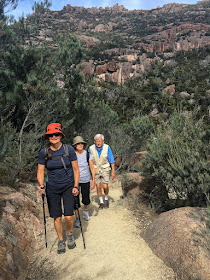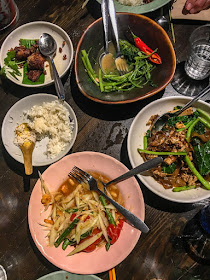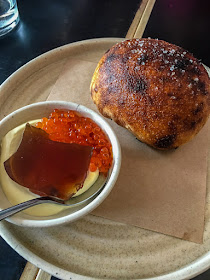
We went for dinner at a Japanese izakaya named Bar Wa. We started with their house made pickles.

Bar Wa Izakaya was Pete’s favorite meal on Tasmania, including the skewers of pork belly, chicken and asparagus.

The four of us reminisced about our 2013 trip to Japan where we had enjoyed several delicious okonomiyaki, savory pancakes, like this one.

The next morning we explored Hobart. The Tasman Fountain is a monument to Abel Tasman, the Dutch explorer who “discovered” the island in 1624 and named it Van Diemen’s Land (after the Governor-General of the Dutch East Indies who financed Tasman’s voyage). Tasmania’s name was officially changed in 1856, and the Aussies like to shorten the names of everything, so they call it Tas or Tassie.

Sealers and whalers settled around Hobart in the early 1800s, and convict transportation from England also increased the population.

Hobart is known for its well-preserved historic architecture, much of it dating back to the Georgian and Victorian eras.
It was fun to wander around, looking at the buildings and parks.
Tas was about ten degrees cooler than Melbourne, giving Patty the perfect reason to buy a new cute wool hat.


Hobart is the capital of Tas and the most populated city on the island state, but it felt small with its population of 225,000.

In our rental car we drove north to Launceston, the second largest city on Tas. We stopped close to the center of Launceston, at the Cataract River Gorge.

We skipped the disappointing chair lift and instead took a nice walk. This is the Alexandra Suspension Bridge.

The pathway dates back to the 1890s and runs along the South Esk River as well as through Cataract Gorge. The lake is 36 meters deep and was formed by erosion of two intersecting faults.

We were impressed by the enormous Dolerite boulders we saw lining the lake.

This is a red spider lily, which is in the amaryllis family.

Cataract Gorge was a good spot for wildlife viewing too. This red-necked wallaby was calmly eating as we watched.

The next day we drove on the Great Eastern Drive to the southern edge of the Bay of Fires and stopped at Binalong Bay.

Patty thought Binalong Bay was gorgeous in the sunlight. Bill noticed that the sand squeaked when we walked barefoot on it and it felt soft.

For lunch we went to nearby Lichen Cafe and had wonderful salad topped with blue-eye trevalla fish that had been caught off the southern shore of Tas.

We saw cyclists enjoying the Great Eastern Drive too, and were impressed that in Tas the law is to give cyclists 1.5 meters to pass, which is 50% more space than California law specifies.

Our Melbourne friend Paul had told us about Middle Aged Men in Lycra (MAMILs) and we learned there’s a movie about them too.

We also spotted a few noisy miners, which are a type of honeyeater that's endemic to southeastern Australia and Tasmania.

We drove to Freycinet National Park, which was founded in 1916 as the first Tas national park.

In this photo Pete was looking at Coles Bay from atop a huge granite boulder. He was surprised to learn that Tasmania is the 2nd driest state in Australia (after Adelaide).

Orthoclase, a pink felspar, gives the mountains their characteristic pink tint. Black micas and white quartz are also found in Freycinet NP. Famous features of the park include its red and pink granite formations and a series of jagged granite peaks in a line called The Hazards.

Our goal was to hike six kilometers up and over to secluded Wineglass Bay and back, so we set off with water and sandwiches. The well-maintained path alternated between dirt and stone steps.

By the end we would climb the equivalent of 83 flights of stairs.

Kristina took a break on this comfortable bench entitled Saddle Seat. It was designed in 2000 by two architecture students.

This pile of sticks represents a white-bellied sea eagle nest. The rangers had built it using the walking sticks left by people at the end of the trail, to make the point that humans are making it harder for the sea eagles to find nesting materials.

The next day we drove to Port Arthur, the former convict settlement 1830-1877 on the Tasmanian Peninsula that is now an open air museum. This building was the penitentiary.

We learned that at its peak there were 2,000 repeat offenders housed at Port Arthur, and that there were beautiful gardens for the people who ran the prison.

It was raining off and on during our visit. We took a boat tour to see the remaining buildings from the water.


The church was completed by the convicts in 1837, and it was used for compulsory religious services for the inmates.

We finished our road trip around Tas by visiting the Museum of Old and New (MONA) near Hobart to see their Skyspace.

Designed by James Turrell and built in 2015, Amarna Skyspace is ideally experienced at sunrise and sunset.

Both Pete and Bill tried lying down and watching the sky change in relation to the lights and the setting sun.

After viewing Amarna we had dinner at the MONA restaurant. Bill was surprised by the variety of restaurants and quality of food we had on Tas, given that it felt relatively rural and not cosmopolitan.

We enjoyed Amarna so much that we returned at sunrise to watch the light show. This was Kristina’s favorite thing we did on Tas.

We flew from Hobart to Sydney. Our Airbnb was located on a small one-way street with trees beginning to show their autumn colors.

The building had been a tram workshop in the 19th century, and was recently converted into residential condominiums.

We went out for great meals while in Sydney. Patty’s favorite meal was Mercado for the nice atmosphere and oysters.

We visited the Museum of Contemporary Art Australia and saw the 21st Biennial exhibit. This is Shellworked Slippers by an Australian Aboriginal artist named Esme Timbery.

And in Waiting Game the Hong Kong artist Nicole Wong used a 20-sided die to determine the size of each circle.

We had eaten at David Thompson’s Nahm in Bangkok, so we were looking forward to trying his home country restaurant.

Patty liked Gelato Messina’s raspberry and chocolate sorbets. She’s holding Bill’s pistachio and chocolate fondant cone, too.
At high tide the waves crash right into the pool, which was thrilling and made it challenging to swim.

Patty’s favorite thing we did in Sydney was Bondi Icebergs because she got to swim in the ocean and the water was not too cold. In this photo she’s waving by the ladder while the waves were buffeting her.

Bill opted out of swimming and instead enjoyed looking at Icebergs and Bondi while we swam. He took some nice photos like this one.

It’s always interesting to see a city from the water, and Sydney has a big harbor. We got lots of different views of the Harbor Bridge.


We took a tour of the opera house. We were excited to see Danish architect Jørn Utzon’s modern expressionist design close up, with its iconic shell roofs.

While the shells appear uniformly white from a distance, they actually feature a subtle chevron pattern and are composed of 1,056,006 tiles in glossy white and matte cream. The tiles were manufactured in Sweden.

Utzon’s design had been chosen in 1957, but it took until 1973 for the building to be completed. The architect also had the vision to have as much glass as possible, to allow for views of the harbor. Utzon won the Pritzker prize for Architecture in 2003.

The cast concrete shell shape is visible in this photo of the interior. The Sydney Opera House was named a UNESCO World Heritage Site in 2007, and it’s the 100th UNESCO site we’ve visited.

The Opera House tour was Bill's favorite activity in Sydney because it enabled him to hear interesting stories about its history. Apparently during a performance of the opera Boris Godunov that featured live chickens, their on-stage pen was accidentally opened and the birds were roaming around the stage until they got scared by the cymbal crashes and one chicken even landed on top of a cellist! This is why nets were installed above the orchestra pit in the Joan Sutherland Theatre. Pictured below is the Concert Hall, the largest performance space in the Opera House.
What a wonderful time we had traveling for three weeks in Australia with Kristina’s folks!

Next Patty and Bill fly back to San Diego, and we fly to Kyoto.























































